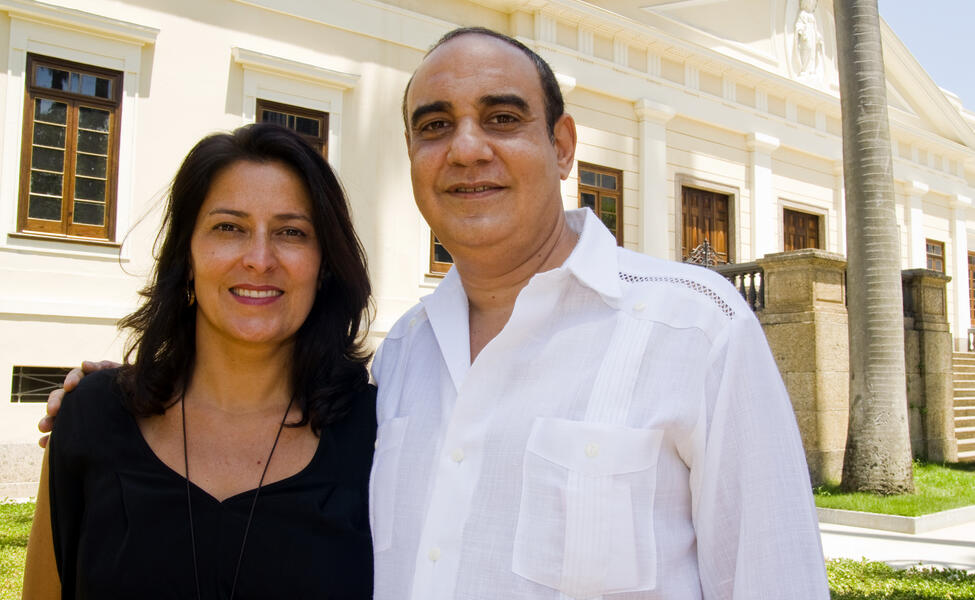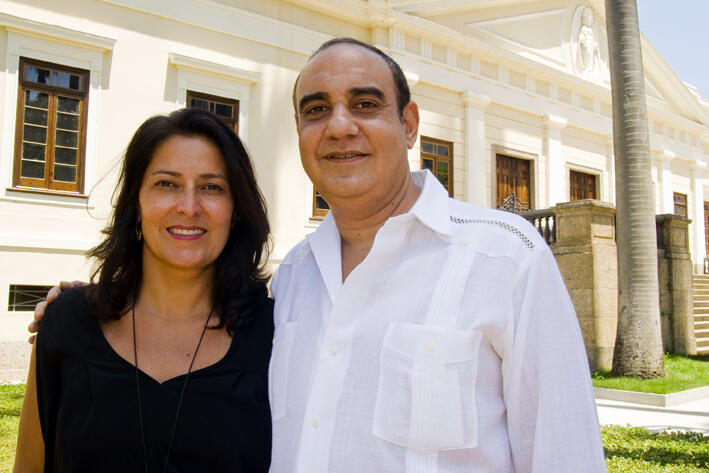CASA DAROS, RIO DE JANEIRO
Interview with Isabella Rosado Nunes and Eugenio Valdes Figueroa
The Brazilian Isabella Rosado Nunes and the Cuban Eugenio Valdés Figueroa are the Directors of Casa Daros in Rio de Janeiro.

Casa Daros, an impressive art center of Swiss origin devoted to Latin American art, will open its doors on March 23, 2013 in the Botafogo district, Rio de Janeiro. The inaugural exhibition, “Cantos Cuentos Colombianos”, will feature works from the Daros holdings by ten artists representative of Colombia: Doris Salcedo, Fernando Arias, José Alejandro Restrepo, Juan Manuel Echavarría, María Fernanda Cardoso, Miguel Ángel Rojas, Nadín Ospina, Oscar Muñoz, Oswaldo Macià and Rosemberg Sandoval.
The project originated in the year 2000, when the Daros Collection Zurich began to gather together contemporary Latin American art. Since then, the collection has not ceased to grow. Today, with holdings that include 1,123 works by 116 contemporary artists and more than 3,500 publications, Daros Latinamerica, promoted by curator Hans Michael Herzog, is the most important collection of its type in Europe.
Art, education, and communication are the axes of the program put into practice by Isabella Rosado Nunes, General Director, and Eugenio Valdés Figueroa, Art and Education Director of Casa Daros in Rio de Janeiro.
In 2006, with the aim of opening its new venue in Latin America, Daros purchased a 19th-century building which had originally been an orphanage for girls, and later a school. An origin which, as we shall see, was in keeping with the project’s educational aspirations.
The restoration of more than 12,000 square meters of a stylistic eclecticism that combines neo-classical and colonial architecture involved a complex and sophisticated task. A row of superb forty-meter high imperial palm trees escorts visitors to the House. On the front façade, over the solid doors of precious woods, a statue of Our Lady of Graces radiates its beauty; then the stone stairway and the solidness of the walls emphasize the feeling that one is entering a fortress. A fortress whose purpose is to preserve and study the art of our time. In the huge central patio, the large granite flagstones have open expansion joints: they filter the rainwater which will be recycled. In a garden, under a tree laden with orchids, are the offices of Rosado Nunes and Valdés Figueroa. There we talked about the optimism they project onto their work, about the collection that will remain in Zurich, since only the works to be shown at the House will cross the ocean, and about their aspiration to persuade Guillermo Kuitca to implement a fellowship program.
Ana Martínez Quijano: Besides your background and nationality, was the contagious optimism that you transmit taken into account at the moment of choosing you as directors of the House?
Isabella Rosado Nunes: I think the term ‘optimism’ is a term which characterizes Daros and the whole project. In order to envision in the year 2000 what the collection might be ten years later, a person must be very optimistic and believe in his or her principles. This project was born of communication, when Hans, the collection’s curator and its owner, Ruth, began to talk with artists and to visit their studios. They felt something was going to happen.
A.M.Q.: How did the idea of settling in Brazil originate?
I.R.N: I don’t know why I was chosen, but I can certainly tell you why they chose Rio. It was after they tried to do something in Havana and realized that there were problems there which exceeded the possibilities of the project. Rio is an international art hub, it is the place chosen by those who travel to Latin America. In search of a space they visited wonderful places, but in this house they found what they were looking for: something more that just a space to show art. This house, which had been devoted to teaching for over a century, could witness the development of the educational project they had conceived from the beginning.
A.M.Q.: How did Eugenio Valdés arrive from Cuba?
I.R.N: When Hans began to assemble the collection, he visited Cuba very often, he attended the biennials, and there he started to buy works. With Eugenio we say that the seed was planted there, that it was sown by Valdés together with Hans, Ruth, and a few more persons who worked at Daros, and by several others who still do.
Eugenio Valdés Figueroa: If we go back to the moment when we started to design the project, we knew from the outset that we had to divide it into phases, because it was huge. Hans did research work; he visited Sao Paulo and Porto Alegre biennials. This cannot be viewed in an isolated way: Daros has great respect for the past of Latin America, its important models and institutions, such as the Di Tella Institute, the Museum of Modern Art in Rio, Casa de las Américas, centers of gravity which assembled the best intellectuals and opened experimental paths.
I.R.N.: The main question is how to gather together in this building art, education, and communication; how to design a project that people can “feel”. There is a collection which has a discourse of its own, and in order to relate it to education, we listen to artists and to an audience that interests us.
A.M.Q.: The whole of Latin America is devoted to educational projects, to research, and to the creation of a theoretical support.
E.V.F.: In our case there are figures such as Paulo Freire, the author of the “Pedagogy of the Oppressed”, who had a strong influence on the pedagogic profile of the project. Freire proposed an education of a dialogic nature. But we must first make it clear that education is the path to approach art. There is no other way. There are myths regarding Latin Americans; it is generally thought that we constitute a homogeneous block, and that is a fiction. We Latin Americans do not know each other enough; we are distant from each other, particularly in the context of art. Latin American countries are not sufficiently interrelated, although there are cyclic moments, dispersions or some commercial boom.
A.M.Q.: Are you referring to a theoretical void?
I.R.N: The discussion has not yet reached the point we want to reach. There are issues that are of special interest to us. Four years ago, during an international meeting of educators, Eugenio proposed for discussion the subject of art and functional illiteracy. Today we witness initiatives to discuss art and education, but there is an aspect that marks a certain difference in our case. We want artists to be the mobilizers of the educational processes; we do not want their action to be limited.
A.M.Q.: You have chosen Julio le Parc for your second exhibition.
I.R.N.: Yes, his will follow the inaugural show. Le Parc came to close a meeting of Latin American artists with Brazilian colleagues. Eugenio entrusted him with the design of a pioneering project, and Julio proposed his own exercises.
A.M.Q.: What sum has Daros invested in Brazil?
I.R.N.: The house cost 16 million reales. But we shall make the sum public when we purchase more works, and you will be surprised by the wise way in which we have handled our resources.
-

Courtesy Casa Daros, Rio de Janeiro/Fabio Caffe/Imagens do Povo.


